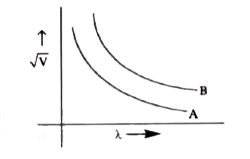De broglie wavelength of particle B is double of particle A and mass of particle A is thrice of mass of particle B. The ratio of velocity of particle A to B isSolution in Malayalam
2:3
3:2
4:3
3:4
Step by step video & image solution for De broglie wavelength of particle B is double of particle A and mass of particle A is thrice of mass of particle B. The ratio of velocity of particle A to B is by Chemistry experts to help you in doubts & scoring excellent marks in Class 11 exams.
Updated on:21/07/2023Topper's Solved these Questions
- STRUCTURE OF ATOMSBOOK - BRILLIANT PUBLICATIONCHAPTER - STRUCTURE OF ATOMSEXERCISE - LEVEL - II
87 Videos
- STRUCTURE OF ATOMSBOOK - BRILLIANT PUBLICATIONCHAPTER - STRUCTURE OF ATOMSEXERCISE - LEVEL - II (ASSERTION - REASON)
5 Videos
- STATES OF MATTER BOOK - BRILLIANT PUBLICATIONCHAPTER - STATES OF MATTER EXERCISE - LEVEL III (Linked Comprehension Type )
9 Videos
- THERMODYNAMICS AND CHEMICAL ENERGETICS BOOK - BRILLIANT PUBLICATIONCHAPTER - THERMODYNAMICS AND CHEMICAL ENERGETICS EXERCISE - (LEVEL-II (HOMEWORK)
39 Videos
Similar Questions
Consider the following statements, which of the following is/are true?
i) Charge to mass ratio of canal rays are found to depend on the gas from which these originate
ii) Cathode rays produce fluorescence and phosphorescence when it hit on the corresponding materials
iii) J.J. Thomson's model of an atom could clearly explain "atom is electrically neutral"
iv) Behaviour of canal rays in the electrical or magnetic field is opposite to that observed for cathode rays
v) Charge to mass ratio of cathode rays are found to depend on the gas from which these originate
View SolutionAssertion : Energy of orbitals in hydrogen atom is 1s<2s=2p<3s=3p=3d<4s=4p=4d=4f
Reason : The energy of orbitals in hydrogen atom is determined by using principal quantum number.
View Solutionwhich of the following statements is correct?
View SolutionWhich of the following is an intensive property
View SolutionA particle A with a mass m_(A) is moving with a velocity v and hits a particle B (mass m_(B) ) at rest (one dimensional motion). Find the change the de-Broglie wavelength of the particle A. Treat the collision as elastic.
View Solutionएक कण, इलेक्ट्रॉन की अपेक्षा तीन गुना अधिक चाल से गति कर रहा है। इस कण की दे ब्रॉगली तरंगदैर्घ्य का इलैट्रॉन की दे ब्रॉगली तरंगदैर्घ्य से अनुपात 1.813×104 है कण के द्रव्यमान का परिकलन कीजिए तथा कण का पहचानिए।
View SolutionThe velocities of two particles A and B are 0.05 and 0.02 m*s^(-1) respectively. The mass of B is five times the mass of A. the ratio of their de Broglie wavelength is-
View Solutionएक कण, इलेक्ट्रॉन, की अपेक्षा तीन गुना अधिक चला से गति रहा है। इस कण का दे ब्रॉग्ली तरंगदैर्घ्य इलेक्ट्रॉन के दे ब्रॉग्ली तरंगदैर्घ्य से अनुपात 1⋅813×10−4 है। कण के द्रव्यमान का परिकलन कीजिए तथा कण को पहचानिए ।
View SolutionThe velocity of particle A is 0.1 ms^(-1) and that of particle B is 0.05 ms^(-1) if the mass of the particle B is five times that of particle A the ratio of De Broglie wavelengths associtated with the particles A and B is
View SolutionTh velocities of two particle A and B are 0.05 and 0.02 ms6(-1) respectively. The mass of B is five times the mass of A.The ratio of their De-Broglie wavelength is
View SolutionThe velocity of particel A is 0.1 m/s and that of particle B is 0.5 m/s. If the mass of particle B is five times that of particle A, then the ratio of de-Broglie wavelength associated with particles A and B is
View SolutionA particle A with a mass mA is moving a velocity v and hits a particle B(mass mB)at rest (one dimensional motion).Find the change in the de-Broglie wavelength of the particle A.Treat the collision as elastic.
View SolutionA:For microscope particles or sub microscopic particles wavelength of de-Broglie is important.
R:If velocity is constant then de-Broglie wavelength is inversely proportional to mass of particle.
View Solutionएक सूक्ष्म कण के द्रव्यमान तथा चाल आधी है तो कण से सम्बन्धित डी - ब्रोगली तरंगदैर्ध्य
View SolutionA particle A with a mass m_(A) is moving with a velocity v and hits a particle B (mass m_(B) ) at rest (one dimensional motion). Find the change in the de-Broglie wavelength of the particle A. Treat the collision as elastic.
View Solution√V of two particles A and B are plotted against de-Broglie wavelengths. where V is the potential on the particles. Which of the following relation is correct about the mass of particles?

View Solution
